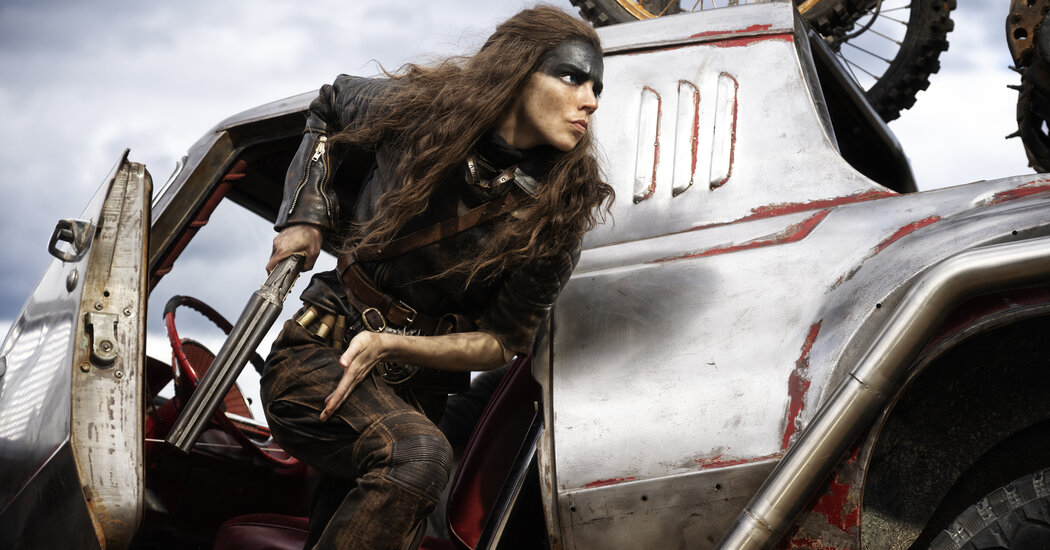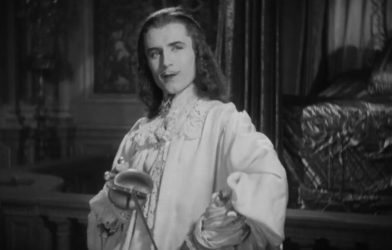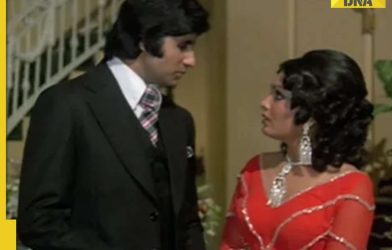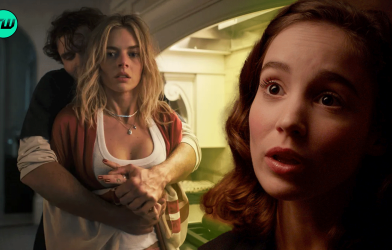Dystopia has rarely looked as grim and felt as exhilarating as it has in George Miller’s “Mad Max” cycle. For decades, Miller has been wowing viewers with hallucinatory images of a ravaged, violent world that looks enough like ours to generate shivers of recognition. Yet however familiar his alternative universe can seem — feel — his filmmaking creates such a strong contact high that it’s always been easy to simply bliss out on the sheer spectacle of it all. Apocalypse? Cool!
The thing is, it has started to feel less cool just because in the years since the original “Mad Max” opened in 1979, the distance between Miller’s scorched earth and ours has narrowed. Set “a few years from now,” the first film tracks Max Rockatansky (Mel Gibson), a highway patrol cop who has a semblance of a normal life with a wife and kid. That things are about to go to hell for Max is obvious in the opening shot of a sign for the Hall of Justice, an entry that evokes the gate at Auschwitz (“Work Sets You Free”). You may have flinched if you made that association, but whatever qualms you had were soon swept away by the ensuing chases and crashes, the gunning engines and mad laughter.
Miller’s latest and fifth movie in the cycle, “Furiosa: A Mad Max Saga,” is primarily an origin story that recounts the life and brutal, dehumanizing times of the young Furiosa (Anya Taylor-Joy), the hard-bitten rig driver played by Charlize Theron in the last film, “Mad Max: Fury Road” (2015). Miller’s magnum opus, “Fury Road” is at once the apotheosis of his cinematic genius — it’s one of the great movies of the last decade — and a departure narratively and tonally from the previous films. In “Fury,” Max still serves as the nominal headliner (with Tom Hardy taking over for Gibson), but the movie’s dramatic and emotional weight rests on Furiosa, her quest and her hopes.
As befits a creation story, “Furiosa” tracks Furiosa from childhood to young adulthood, a downward spiral that takes her from freedom to captivity and, in time, circumscribed sovereignty. It opens with the 10-year-old Furiosa (Alyla Browne) foraging in a forest close to a paradisiacal outpost called the Green Place of Many Mothers. Just as she’s reaching for an amusingly, metaphorically ripe peach, her idyll is cut short by a gang of snaggletooth, hygiene-challenged bikers. They’re soon rocketing across the desert with Furiosa tied up on one of their bikes, with her mother (Charlee Fraser) and another woman in pursuit on horseback, a chase that presages the fight for power and bodies which follows.
The chase grows exponentially tenser as Miller begins shifting between close-ups and expansive long shots, the raucous noise and energy of the kidnappers on their hell machines working contrapuntally against the desert’s stillness. While the scene’s arid landscape conjures up past “Mad Max” adventures, the buttes and the galloping horse evoke the classic westerns from which this series has drawn some of its mythopoetic force. Max has often seemed like a Hollywood gunslinger (or samurai) transplanted into Miller’s feverish imagination with some notes from Joseph Campbell. The minute Furiosa starts gnawing on her captor’s fuel line, though, Miller makes it clear that this wee captive is no damsel in distress.
Furiosa’s odyssey takes a turn for the more ominous when she’s delivered to the bikers’ ruler, Warlord Dementus (a vamping Chris Hemsworth), a voluble show-boater who oversees a gaggle of largely male nomads. Wearing a billowing white cape, Dementus travels in a chariot drawn by motorcycles and keeps a scholar by his side. He’s a ridiculous figure, and Miller and Hemsworth lean into the character’s absurdity with a physical presentation that is as outlandish as Dementus’s pomposity and (prosthetic) nose. It’s hard not to wonder if Miller drew inspiration for the character from both Charlton Heston’s heroic champion and the Arab sheikh in the 1959 epic “Ben-Hur,” a very different desert saga.
The power of the “Mad Max” movies partly derives from how Miller supercharges the kinds of stories that are passed from family to family, tribe to tribe, culture to culture, the ones that are embedded in our heads and chart our paths, whether we know it or not. Yet while Miller is a modern mythmaker, he remains tethered to the world — the machinations and conflagrations in the movies at times queasily mirror our own — and it’s worth noting that he’s also a physician. (He was the set doctor on some “Max” movies.) His background helps explain, I think, his attention to the human body, most obviously in the flamboyant stunt work that has become a series trademark, and his delight in showing the whirring parts of bodies, machines and ecosystems — how they work.
Furiosa’s own body is very much at the center of this movie, which shifts directions when, after some power plays and narrative busywork, she lands in the Citadel, the heavily guarded fortress the character fled in “Fury Road.” There, she is herded with some cloistered young women, handmaidens whose sole function is to bear children for Immortan Joe (Lachy Hulme), the Citadel’s leader. It’s also there that Furiosa, still a child (and still played by Browne), catches the eye of one of Immortan Joe’s spawn, a hulking predator whose designs on her jolt the story into a different, unsettling register. Miller, smartly, doesn’t overplay this section — and Furiosa evades this creep — but it’s still a shock to the system.
The shock lingers, and darkens the story precipitously. To survive, Furiosa escapes her would-be molester by obscuring her identity and joining the ranks of the Citadel’s chattel workers. She melts into the crowd, and years pass as the scenes blend together and a determined, sympathetic Taylor-Joy steps into the role. There’s more, lots and lots: Furiosa shaves her head and finds a mentor in a driver, Praetorian Jack (Tom Burke, the louche heartbreaker in Joanna Hogg’s “The Souvenir”). Together they and armies of minions journey to hot spots like the Bullet Farm, where Miller dazzles you with his customary pyrotechnics as he finesses the pieces — Immortan Joe and Dementus included — into place.
It takes a while to get used to Taylor-Joy as Furiosa, partly because Theron originated the character with such a distinct mixture of raw anger and deep-boned melancholy. Theron also looked like she could kick everyone’s butt in “Fury Road”; she more or less kicked Max’s, at least metaphorically by becoming the series’ new totem. Taylor-Joy doesn’t (yet) have her predecessor’s physical expressiveness, but like Theron, she trained as a ballet dancer and moves beautifully, with the kind of unforced gracefulness that suggests she can easily slip out of any difficulty. Taylor-Joy’s Furiosa may look too physically slight to handle the Armageddon, but that sense of vulnerability of course serves the story.
My guess is that Miller chose Taylor-Joy as his new Furiosa in part because of the actress’s large, wide-set eyes. They’re enormous; they’re also mesmerizing. They lock your own gaze down, commanding your attention, never more so than when the actress is looking up with her head bowed. It’s an angle that accentuates the whites of her eyes, which shine especially bright in the Citadel’s sepulchral lighting. (Jack Nicholson perfected this menacing technique in “The Shining,” which is why it’s called the Kubrick Stare.) The effect can be greatly destabilizing, creating uncertainty about the character and what kind of hero she’ll prove to be.
Furiosa’s reticence is strategic, as well as a trait she shares with Mad Max himself, the model for her taciturn avenger. While Furiosa is hiding in plain sight in the Citadel, her circumspection protects her, but it also accentuates her existential plight. She’s alone, spiritually and in every other respect, at least before meeting Praetorian Jack (not that they’re chatty). Hers is a lonely burden and, as the story and the fighting continue, it gives “Furiosa” a surprising emotional heaviness which can make this exciting, kinetic movie feel terribly sad.
Scene for scene, “Furiosa” is very much a complement to “Fury Road,” yet the new movie never fully pops the way the earlier one does. As it turns out, it is one thing to watch a movie about warriors high-tailing it out of Dodge on the road to nowhere. It’s something else entirely to watch a woman struggle to survive a world that eats its young and everyone else, too. Miller is such a wildly inventive filmmaker that it’s been easy to forget that he keeps making movies about the end of life as we know it. It’s a blast watching his characters fight over oil, water and women, yet while I’ve long thought of him as a great filmmaker it’s only with “Furiosa” that I now understand he’s also one kick-ass prophet of doom.
Furiosa: A Mad Max Saga
Rated R for dystopian violence and intimations of child predation. Running time: 2 hours 28 minutes. In theaters.









